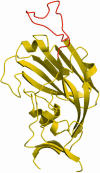An unexpected antibody response to an engineered influenza virus modifies CD8+ T cell responses
- PMID: 16473934
- PMCID: PMC1413843
- DOI: 10.1073/pnas.0511185103
An unexpected antibody response to an engineered influenza virus modifies CD8+ T cell responses
Abstract
The ovalbumin(323-339) peptide that binds H2I-A(b) was engineered into the globular heads of hemagglutinin (H) molecules from serologically non-cross-reactive H1N1 and H3N2 influenza A viruses, the aim being to analyze recall CD4+ T cell responses in a virus-induced respiratory disease. Prime/challenge experiments with these H1ova and H3ova viruses in H2(b) mice gave the predicted, ovalbumin-specific CD4+ T cell response but showed an unexpectedly enhanced, early expansion of viral epitope-specific CD8+ T cells in spleen and a greatly diminished inflammatory process in the virus-infected respiratory tract. At the same time, the primary antibody response to the H3N2 challenge virus was significantly reduced, an effect that has been associated with preexisting neutralizing antibody in other experimental systems. Analysis of serum from the H1ova-primed mice showed low-level binding to H3ova but not to the wild-type H3N2 virus. Experiments with CD4+ T cell-depleted and Ig-/- mice indicated that this cross-reactive Ig is indeed responsible for the modified pathogenesis after respiratory challenge. Furthermore, the effect does not seem to be virus-dose related, although it does require infection. These findings suggest intriguing possibilities for vaccination and, at the same time, emphasize that engineered modifications in viruses may have unintended immunological consequences.
Conflict of interest statement
Conflict of interest statement: No conflicts declared.
Figures





References
Publication types
MeSH terms
Substances
Grants and funding
LinkOut - more resources
Full Text Sources
Medical
Research Materials

